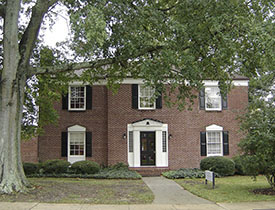ECU's 2006 Fall Field School
Project Journal
6 October 2006
By Calvin Mires

Last Monday (October 2) I walked into our meeting room and immediately noticed some dramatic changes in the crew. Gone was the trodden, baggy-eyed sheen of spending long hours in muddy water, wind, and sun. No longer detectable were the eclectic aromas wafting from saturated neoprene, grease, gas, and clothing that seemed to have had a disagreeable falling out with any sort of washing apparatus since the beginning of the project. The monosyllabic grunts and utterances that conveyed hearty "Good mornings!" and other less intelligible meanings were nowhere to be found. Instead, I was greeted with fresh faces, clean clothes, washed hair, and eyes that were bright and well-rested. It truly seemed that the crew had scrubbed away the final vestiges of a month of working in the Pamlico River - a month that had its fair share of challenges to overcome, a month where nothing went quite as planned, and a month that reminded me why I enjoy fieldwork so much.

The Eller House, home of the Program in Maritime Studies and where students will now spend most of their time working on collected data.
During this month, students were assigned to design recording strategies for the two sites we investigated, Site A (Field Entries, Day 1 - Day 7), and Site B that we unofficially termed, the Padgett vessel (Field Entries, Day 8 - 18). They presented sound rationale for choosing their particular strategies and offered well conceived plans to achieve their goals. One day into field work, however, it became clear that Sites A and B along with our equipment had little regard (or respect) for the students' carefully designed recording strategies. While a strange "oily" environmental concern halted operations at Site A, the most consistent nemesis impeding our progress came from a generally lethargic, often cranky, and occasionally spiteful dredge engine (for more complete detail of problems with dredge engines, dredging, and other dredge related issues please read Field Entries, Day 4 - Day 18). At times, it appeared we were simply spinning our wheels and time was slipping away. There was a lot of effort, but little to show for the work-until the last week.
Mosaic of mylar connecting the Padgett vessel's site plan.
It were these final seven to ten days that reminded me why I enjoy fieldwork. Through all the problems and all the challenges, things usually work out by the end (even if somewhat modified from the original course of action). Of course, this requires cooperation and persistent effort from everyone. (I also find that healthy doses of optimism bordering on delusion and sarcasm help to mitigate any creeping doubts of accomplishment). The crew for this project marshaled these qualities to map the entire Padgett vessel (see Day 14 – Day 18 for details) from various perspectives. They remained focused on their project goals but were flexible enough to redefine their strategies and their roles within those plans.
As they met for the first time since the end of fieldwork on Monday, they faced the moment of truth. They began putting their individual Mylar sheets, containing the section of vessel they recorded, next to everybody else's sheets like pieces of a jigsaw puzzle. Soon they learn whether all their efforts were fruitful or futile, based on how well they respective drawings matched. As the last couple of "pieces" were put on the table, smiles and quiet congratulations affirmed that they had succeeded. There was a scaled site plan of the Padgett vessel lying before our eyes, and each piece fit well in place. While they discussed each other's handiwork and began posing questions about the construction of the vessel, I let out a small sigh of relief, smiled, and mentally quoted a line from Monty Python's Holy Grail, "...and there was much rejoicing."
This is not the end of the field school, however, nor is it the end of our journal entries. As Trish noted in her entry last Friday (September 29), the work has really just started. The crew must now produce a complete site map, record and catalog artifacts, continue research on the various vessels, re-create the potential shape and lines of the Padgett vessel, and continue contributing to this project journal.
That's right! After a brief hiatus while we were re-organizing at the Eller House, our home at ECU, we are now ready to bring the second phase of the field school to you. The only change is that we will have weekly entries instead of daily. The first one starts next week with Amy, who is looking forward to another Monday entry for which she's become famous. Like before the students will bring their unique perspective on the week's events. While I am not sure what they will say (I have enjoyed reading their take on the day's events as much as anyone), I am confident there will be much less discussion about dredges!
Before we leave the field work phase completely, we must take time to thank the following: the City of Washington, N.C.; Blount Rumley and the staff at the North Carolina Estuarium; Chris Padgett and his family; and Eric Diaddorio. Dr. David Stewart, the crew, and I thank you for your help, hospitality, and efforts on our behalf. Without you this project would not have been possible.
For more information you can visit the ECU website at:
http://www.ecu.edu/maritime/index.htm
Return to Project Journal home page.

